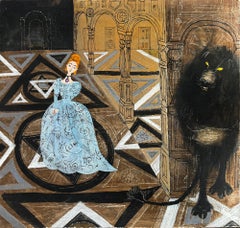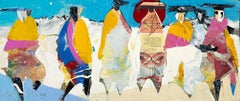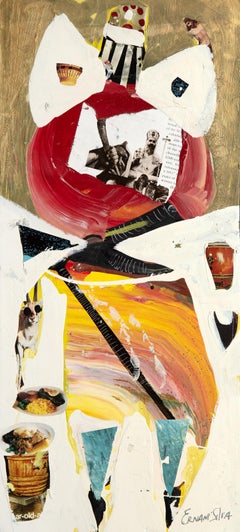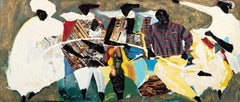Folk Art Figurative Paintings
1970s Folk Art Figurative Paintings
Gouache, Illustration Board
Late 20th Century Folk Art Figurative Paintings
Wood, Paint
1990s Folk Art Figurative Paintings
Enamel
1990s Folk Art Figurative Paintings
Enamel
1990s Folk Art Figurative Paintings
Enamel
1990s Folk Art Figurative Paintings
Enamel
1990s Folk Art Figurative Paintings
Enamel
1960s Folk Art Figurative Paintings
Cotton Canvas, Oil
2010s Folk Art Figurative Paintings
Oil
2010s Folk Art Figurative Paintings
Canvas, Oil Crayon, Acrylic
Early 2000s Folk Art Figurative Paintings
Acrylic, Canvas
2010s Folk Art Figurative Paintings
Oil, Canvas
20th Century Folk Art Figurative Paintings
Gouache
2010s Folk Art Figurative Paintings
Canvas, Oil
Mid-20th Century Folk Art Figurative Paintings
Masonite, Oil
20th Century Folk Art Figurative Paintings
Gouache
Early 1900s Folk Art Figurative Paintings
Canvas, Oil
20th Century Folk Art Figurative Paintings
Paint, Board
20th Century Folk Art Figurative Paintings
Gouache
20th Century Folk Art Figurative Paintings
Gouache
Artist Comments
A woman gazes with intense blue eyes, her contemplative expression framed by luscious hair and a geometric-patterned earring. A white bird perches on her shou...
21st Century and Contemporary Folk Art Figurative Paintings
Acrylic
20th Century Folk Art Figurative Paintings
Gouache
1950s Folk Art Figurative Paintings
Masonite, Oil
Early 20th Century Folk Art Figurative Paintings
Canvas, Tempera
1990s Folk Art Figurative Paintings
Mixed Media, Spray Paint
2010s Folk Art Figurative Paintings
Cotton Canvas, Mixed Media, Acrylic, Stretcher Bars
1960s Folk Art Figurative Paintings
Oil, Board
Mid-20th Century Folk Art Figurative Paintings
Oil, Board
21st Century and Contemporary Folk Art Figurative Paintings
Oil Pastel, Archival Paper
20th Century Folk Art Figurative Paintings
Oil
21st Century and Contemporary Folk Art Figurative Paintings
Paper, Acrylic
21st Century and Contemporary Folk Art Figurative Paintings
Wood, Acrylic, Board
Early 2000s Folk Art Figurative Paintings
Acrylic, Board
Artist Comments
A fashionable young woman sporting sunglasses, favorite denim pants, and vibrant red boots steps out into a windy early spring day for a brisk walk with her c...
21st Century and Contemporary Folk Art Figurative Paintings
Acrylic
1990s Folk Art Figurative Paintings
Paint, Handmade Paper
1980s Folk Art Figurative Paintings
Acrylic, Canvas
20th Century Folk Art Figurative Paintings
Canvas, Oil
1960s Folk Art Figurative Paintings
Canvas, Oil
20th Century Folk Art Figurative Paintings
Gouache
Early 20th Century Folk Art Figurative Paintings
Paper, Ink, Pigment
2010s Folk Art Figurative Paintings
Mixed Media, Acrylic, Wood Panel
Late 20th Century Folk Art Figurative Paintings
Metal
Mid-20th Century Folk Art Figurative Paintings
Canvas, Oil
20th Century Folk Art Figurative Paintings
Oil, Board
20th Century Folk Art Figurative Paintings
Canvas, Oil
20th Century Folk Art Figurative Paintings
Gouache
2010s Folk Art Figurative Paintings
Canvas, Acrylic, Tempera
Early 2000s Folk Art Figurative Paintings
Acrylic, Board, Pen
Mid-20th Century Folk Art Figurative Paintings
Oil
1950s Folk Art Figurative Paintings
Oil
Artist Comments
"The subtle feminine face in this piece displays an expression of definite reluctance to commitment," says artist Sharon Sieben. A woman bathed...
21st Century and Contemporary Folk Art Figurative Paintings
Acrylic
Late 20th Century Folk Art Figurative Paintings
Mixed Media, Board
2010s Folk Art Figurative Paintings
Wood, Oil
1970s Folk Art Figurative Paintings
Crayon, Mixed Media
2010s Folk Art Figurative Paintings
Jute, Wood, Oil, Canvas
2010s Folk Art Figurative Paintings
Oil Crayon, Acrylic, Wood Panel
2010s Folk Art Figurative Paintings
Canvas, Acrylic, ABS
Late 20th Century Folk Art Figurative Paintings
Wood, Mixed Media
2010s Folk Art Figurative Paintings
Canvas, Acrylic
2010s Folk Art Figurative Paintings
Acrylic




